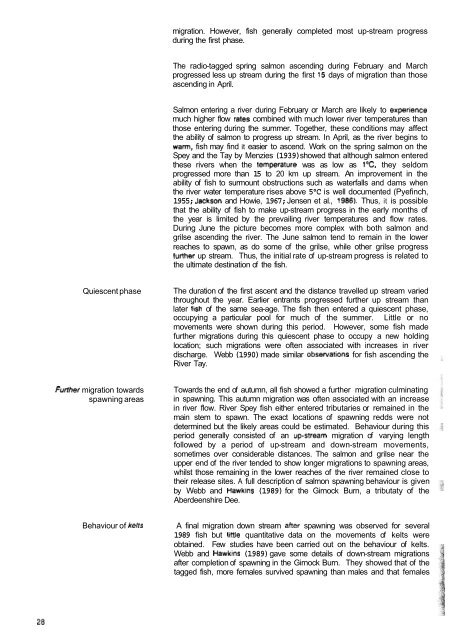( Salmo salar L.) in the River Spey as determined by
( Salmo salar L.) in the River Spey as determined by
( Salmo salar L.) in the River Spey as determined by
Create successful ePaper yourself
Turn your PDF publications into a flip-book with our unique Google optimized e-Paper software.
migration. However, fish generally completed most up-stream progress<br />
dur<strong>in</strong>g <strong>the</strong> first ph<strong>as</strong>e.<br />
The radio-tagged spr<strong>in</strong>g salmon <strong>as</strong>cend<strong>in</strong>g dur<strong>in</strong>g February and March<br />
progressed less up stream dur<strong>in</strong>g <strong>the</strong> first 15 days of migration than those<br />
<strong>as</strong>cend<strong>in</strong>g <strong>in</strong> April.<br />
<strong>Salmo</strong>n enter<strong>in</strong>g a river dur<strong>in</strong>g February or March are likely to experience<br />
much higher flow rates comb<strong>in</strong>ed with much lower river temperatures than<br />
those enter<strong>in</strong>g dur<strong>in</strong>g <strong>the</strong> summer. Toge<strong>the</strong>r, <strong>the</strong>se conditions may affect<br />
<strong>the</strong> ability of salmon to progress up stream. In April, <strong>as</strong> <strong>the</strong> river beg<strong>in</strong>s to<br />
wan, fish may f<strong>in</strong>d it e<strong>as</strong>ier to <strong>as</strong>cend. Work on <strong>the</strong> spr<strong>in</strong>g salmon on <strong>the</strong><br />
<strong>Spey</strong> and <strong>the</strong> Tay <strong>by</strong> Menzies (1939) showed that although salmon entered<br />
<strong>the</strong>se rivers when <strong>the</strong> temperature w<strong>as</strong> <strong>as</strong> low <strong>as</strong> 1°C, <strong>the</strong>y seldom<br />
progressed more than 15 to 20 km up stream. An improvement <strong>in</strong> <strong>the</strong><br />
ability of fish to surmount obstructions such <strong>as</strong> waterfalls and dams when<br />
<strong>the</strong> river water temperature rises above 5°C is well documented (Pyef<strong>in</strong>ch,<br />
1955; Jackson and Howie, 1967; Jensen et al., 1986). Thus, it is possible<br />
that <strong>the</strong> ability of fish to make up-stream progress <strong>in</strong> <strong>the</strong> early months of<br />
<strong>the</strong> year is limited <strong>by</strong> <strong>the</strong> prevail<strong>in</strong>g river temperatures and flow rates.<br />
Dur<strong>in</strong>g June <strong>the</strong> picture becomes more complex with both salmon and<br />
grilse <strong>as</strong>cend<strong>in</strong>g <strong>the</strong> river. The June salmon tend to rema<strong>in</strong> <strong>in</strong> <strong>the</strong> lower<br />
reaches to spawn, <strong>as</strong> do some of <strong>the</strong> grilse, while o<strong>the</strong>r grilse progress<br />
fufiher up stream. Thus, <strong>the</strong> <strong>in</strong>itial rate of up-stream progress is related to<br />
<strong>the</strong> ultimate dest<strong>in</strong>ation of <strong>the</strong> fish.<br />
Quiescent ph<strong>as</strong>e<br />
The duration of <strong>the</strong> first <strong>as</strong>cent and <strong>the</strong> distance travelled up stream varied<br />
throughout <strong>the</strong> year. Earlier entrants progressed fur<strong>the</strong>r up stream than<br />
later fish of <strong>the</strong> same sea-age. The fish <strong>the</strong>n entered a quiescent ph<strong>as</strong>e,<br />
occupy<strong>in</strong>g a particular pool for much of <strong>the</strong> summer. Little or no<br />
movements were shown dur<strong>in</strong>g this period. However, some fish made<br />
fur<strong>the</strong>r migrations dur<strong>in</strong>g this quiescent ph<strong>as</strong>e to occupy a new hold<strong>in</strong>g<br />
location; such migrations were often <strong>as</strong>sociated with <strong>in</strong>cre<strong>as</strong>es <strong>in</strong> river<br />
discharge. Webb (1990) made similar obsewations for fish <strong>as</strong>cend<strong>in</strong>g <strong>the</strong><br />
<strong>River</strong> Tay.<br />
Furlher migration towards<br />
spawn<strong>in</strong>g are<strong>as</strong><br />
Towards <strong>the</strong> end of autumn, all fish showed a fur<strong>the</strong>r migration culm<strong>in</strong>at<strong>in</strong>g<br />
<strong>in</strong> spawn<strong>in</strong>g. This autumn migration w<strong>as</strong> often <strong>as</strong>sociated with an <strong>in</strong>cre<strong>as</strong>e<br />
<strong>in</strong> river flow. <strong>River</strong> <strong>Spey</strong> fish ei<strong>the</strong>r entered tributaries or rema<strong>in</strong>ed <strong>in</strong> <strong>the</strong><br />
ma<strong>in</strong> stem to spawn. The exact locations of spawn<strong>in</strong>g redds were not<br />
determ<strong>in</strong>ed but <strong>the</strong> likely are<strong>as</strong> could be estimated. Behaviour dur<strong>in</strong>g this<br />
period generally consisted of an up-stream migration of vary<strong>in</strong>g length<br />
followed <strong>by</strong> a period of up-stream and down-stream movements,<br />
sometimes over considerable distances. The salmon and grilse near <strong>the</strong><br />
upper end of <strong>the</strong> river tended to show longer migrations to spawn<strong>in</strong>g are<strong>as</strong>,<br />
whilst those rema<strong>in</strong><strong>in</strong>g <strong>in</strong> <strong>the</strong> lower reaches of <strong>the</strong> river rema<strong>in</strong>ed close to<br />
<strong>the</strong>ir rele<strong>as</strong>e sites. A full description of salmon spawn<strong>in</strong>g behaviour is given<br />
<strong>by</strong> Webb and Hawk<strong>in</strong>s (1989) for <strong>the</strong> Girnock Burn, a tributaty of <strong>the</strong><br />
Aberdeenshire Dee.<br />
Behaviour of kelts<br />
A f<strong>in</strong>al migration down stream after spawn<strong>in</strong>g w<strong>as</strong> observed for several<br />
1989 fish but little quantitative data on <strong>the</strong> movements of kelts were<br />
obta<strong>in</strong>ed. Few studies have been carried out on <strong>the</strong> behaviour of kelts.<br />
Webb and Hawk<strong>in</strong>s (1989) gave some details of down-stream migrations<br />
after completion of spawn<strong>in</strong>g <strong>in</strong> <strong>the</strong> Girnock Burn. They showed that of <strong>the</strong><br />
tagged fish, more females survived spawn<strong>in</strong>g than males and that females
















